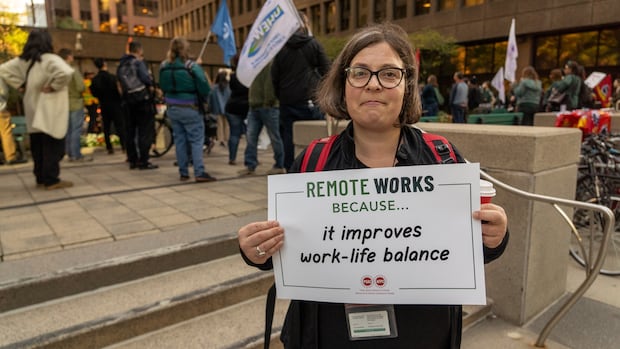
Federal officials pointed to concerns about “public scrutiny” when the government mandated workers back into the office, even as workers reported they felt more productive working from home, documents show.
Documents prepared by the Treasury Board Secretariat (TBS) before the announcements of return to the office mandates were released to the Public Service Alliance of Canada (PSAC) under an access to information request, and shared with CBC News.
The documents show how TBS looked at global trends, raised concerns about public trust and had very little internal information on productivity when deciding to mandate workers back to the office.
The union says the documents point to the lack of justification for the mandated return to the office.
“They had an opportunity here to really modernize the public service and move it forward, and yet here we are talking about cookie cutter approaches, butts in seats, and we’re not really talking about services to those who reside in Canada,” said Sharon DeSousa, president of PSAC.

Shifting options
Almost a full year before the three-day-a-week mandate was announced, a slide deck recommended a “flexible first” option “without prescribed office parameters” for those who can do their work remotely.
That option is touted for potential gains in productivity, the diversity and geographic distribution of talent in the public service, and reducing the government’s office and environmental footprint.
The deck, prepared for the office of the chief human resource officer in May 2022, notes the “flexible first” option could be disruptive for management and “could be subject to negative public scrutiny.”
Option 2 was an “ad hoc” model that was primarily on site but accepted some telework, and option three is “scheduled” office time.
Potential options changed in the lead-up to the April 2024 decision on the three-day mandate.
At that point, officials were considering three different options, and “flexible first” was off the menu. They could maintain the prescribed two- to three-days-a-week mandate with departmental flexibility, require executives return three days a week or require “enterprise re-adjustment” to three days a week for all workers.
The latter option, which was ultimately adopted, would “eliminate inconsistencies” between departments but was flagged as being the “more disruptive option” of the three. In the end, executives were required to return to the office four days a week.
“To me, it seems like politics got in the way. It seems like another agenda got put on the table and the government chose to go that route because the evidence isn’t there to support this mandate,” DeSousa said.
The recent return of federal workers to their offices three days a week has more commuters circling the block for scarce parking spots in downtown Ottawa and Gatineau. As CBC’s Matthew Kupfer reports, commuters and parking lots are adjusting to the rise in demand.
‘Evidence gaps’ on hybrid rollout
An October 2023 update on the federal government’s first hybrid work mandate acknowledged the lack of data.
“Enterprise-wide evidence gaps remain on how hybrid is working in individual teams, departments and for employees,” the document said.
It noted that by fall 2023, 81 per cent of departments were requiring at least two days a week at that time
Sixty-four per cent of departments could report at least 60 per cent of employees were complying with the in-office mandate.
About 28 per cent of departments did not provide data that could be used for comparison.
PSAC said any issues with compliance should have been addressed on an individual basis.
“If there’s issues, deal with the issues. You don’t impose a three-day in-office mandate as a result,” DeSousa said.
Managers were also reporting emerging issues with the initial return to the office mandate including managing change, lack of workspace and the shift to unassigned seating.
Federal public servants were expected to be back in the office three days a week starting Monday, but the transition in Ottawa was anything but smooth.
The productivity question
The documents include summaries and presentations about external research on hybrid and remote work policies in public and private workplaces.
The research suggests the question of productivity is highly subjective — with managers and employees assessing the shift to hybrid work differently.
The research suggests no loss in productivity in hybrid work environments, but is not definitive about any significant gains for the employer.
A 2023 survey of 1,320 federal employees included in the document showed overwhelming support for remote work.
The top benefit employees cited was better productivity, and 28 per cent said they saw no downside to remote work for themselves, their team or organization.
Without explicitly mentioning productivity, an October 2023 update on the first phase of the return to the office noted that “adoption of hybrid work models happened slowly at the same time Canadians experienced delays in service delivery.”
Treasury Board working group
In a statement, TBS said the return to office policy is meant to build stronger teams and culture, contribute to better service delivery for Canadians and reinforce confidence in the public service.
“Aligning with national and global trends helps strengthen the credibility of the public service and supports the government of Canada’s ongoing efforts to recruit new talent in a variety of functions,” it said in a statement.
TBS has since announced a working group to examine productivity in the public service and remove regulatory barriers. The working group’s membership and mandate is still being developed, according to a statement.
TBS said performance measures are managed at the departmental level, and it’s up to each manager to evaluate their employees’ performance.
In their statement, TBS said the three-day-a-week mandate still offers flexibility.
Risk of losing employees
The documents showed differences in hybrid work models led to recruitment and retention problems in some organizations with less opportunity to work from home.
A recent report from the C.D. Howe Institute says there isn’t much difference in the availability of remote work arrangement between the public and private sector — at least in work with similar qualifications.
Tammy Schirle, an economist at Wilfrid Laurier University who wrote the report, says even as the federal mandate was trying to even the playing field between departments struggling to retain workers seeking flexibility, it could put the whole of the public service at a disadvantage.
“Those same employees who were searching for a job in another department or another unit, they could just as easily start looking for a job somewhere entirely outside of the federal government,” she said.
“That is where I would worry most about us losing our best public servants to these other industries where they’re going to find that flexibility with good pay.”

